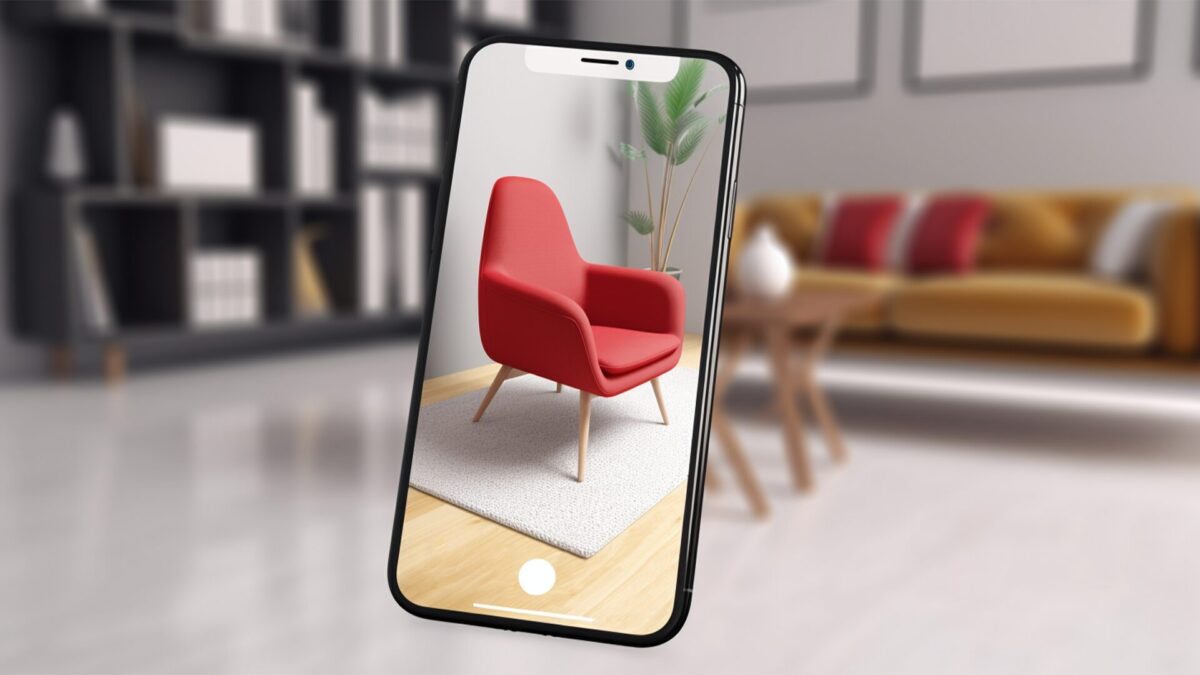
While the e-commerce furniture industry remains healthy after the pandemic, furniture retailers must maintain momentum. Experts share best practices and next moves that will meet evolving consumer preferences and behaviors for greater personalization that can result in increased loyalty and sales.
Inside this article:
What is furniture e-commerce?
Furniture e-commerce is a way to sell and buy furniture and home goods on digital platforms. It covers every part of the buyer’s journey. The steps are initial search, browsing, selection, purchase, delivery, assembly instructions, and returns.
The pandemic paved the way for the growth of furniture e-commerce. Jessie Healy, Co-founder and CMO of e-commerce marketing agency Webtopia, reflects, “We saw a big uptick in furniture purchases happening online. People were investing in making their physical spaces more comfortable and appealing. They were forced to try e-commerce even if they hadn’t shopped this way before.”
that only provide text and images are missing the opportunity to win over consumers with more deeply engaging experiences,” says Beck Besecker, CEO and Co-founder of 3D Cloud by Marxent. “The furniture online consumer experience (FOCE) that defines customer satisfaction is 3D e-commerce. Brands like Wayfair, IKEA, Lowe’s and Amazon, which create outstanding personalized customer experiences have it right. There’s only one focus that counts: the consumer.”
Elements of 3D e-commerce: Interactivity and immersion for the furniture consumer
As technology evolves, so does the 3D e-commerce experience for the consumer. This brief terminology overview explains how each works in e-commerce.
- Three-dimensional (3D): Interactive 3D product models allow shoppers to view products from multiple angles and perspectives. They can zoom in and out, as well as rotate and interact with the item in real time. This collection of 3D rendering examples shows you how it works.
- Augmented Reality (AR): Enhancing reality with virtual objects allows shoppers to point their devices in a room and add digital elements to a live view of the world. Shoppers typically access AR apps via a smartphone.
- Virtual Reality (VR): This experience immerses the shopper in a fully digital, simulated environment—usually requiring a specially designed headset.
- Mixed Reality (MR): The shopper interacts with real and virtual objects simultaneously with a combination of AR and VR technology. Learn more about how MR works and see examples.
- Artificial Intelligence (AI): Visual AI combines all the 3D visual elements and adds computer vision, machine learning, and human-computer interaction to enable visual recognition and inference.
Key Takeaways
- The industry is redefining furniture e-commerce as 3D e-commerce.
- Increasing personalization is the way to win and maintain customer loyalty.
- 3D e-commerce is becoming a top trend for 2024, but retailers using it to drive shoppers to physical stores is a table stakes.
Top trends for furniture e-commerce 2024 and beyond
The top 2024 furniture e-commerce trends reflect today’s always-connected consumers. Tech-savvy buyers desire convenience, personalization, customization, and sustainability. These trends apply to every buyer segment, particularly to Millennials.
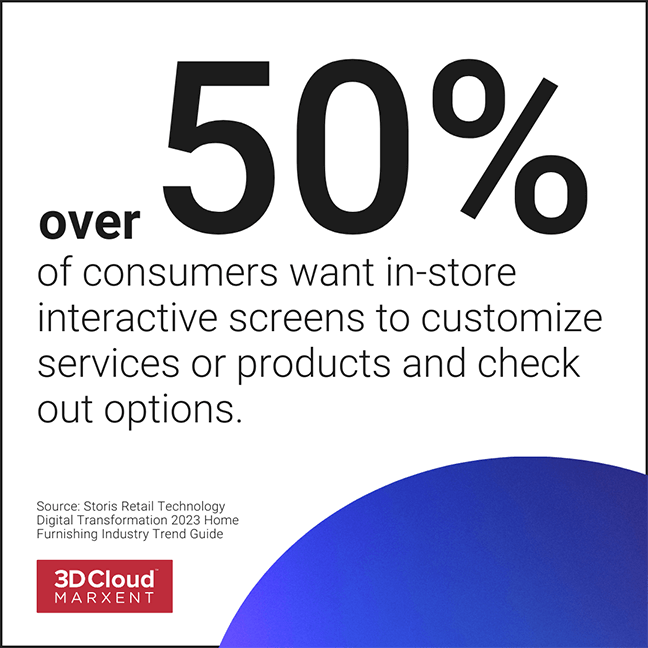
- Unified commerce:
A seamless in-store and online experience unifies all channels, products, payment systems, and customer interactions. Unified commerce gives customers an integrated and frictionless experience and offers sellers measurability. Mood Media research in its Charting In-Store Trends Report of October 2022 reports that “customers now increasingly see both online and offline as part of the same purchase journey and…expect similar levels of digital technology solutions as an integral part of the physical space.”
- Virtual design services:
Free interior design services are an excellent top-of-the-funnel tool to generate leads. Offering a way for a customer to visualize the space leads to extended virtual experiences and longer time on site. A few e-commerce platforms that offer free design services include La-Z-Boy, Crate and Barrel, Ethan Allen, Pottery Barn, and West Elm. Everyone appreciates a free service, good visuals, and the individualized touch (showing even more options) leads to higher conversion rates.
- 3D commerce:
Immersive retail experiences using 3D product configurators, 3D room planners, and 3D product visualization bring consumers closer to items. This practice helps remove perceived risk sometimes associated with buying online. A 2023 Forrester Consulting study found that 70% of companies in the survey identified 3D visualization to enable revenue growth. Thirty-nine percent of responding companies believe 3D reduces product returns.
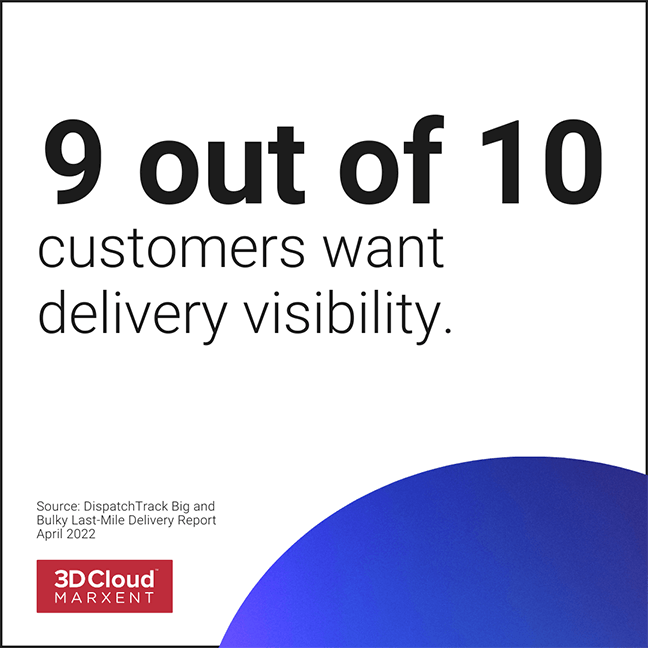
- Delivery visibility:
Amazon set the delivery standard. Now, approximately 90% of consumers want to be able to track their orders, according to DispatchTrack’s 2022 Big and Bulky Delivery Reports. Adopt a solution to streamline, automate, and trace goods from when the customer clicks the buy button. The result is customer happiness and loyalty.
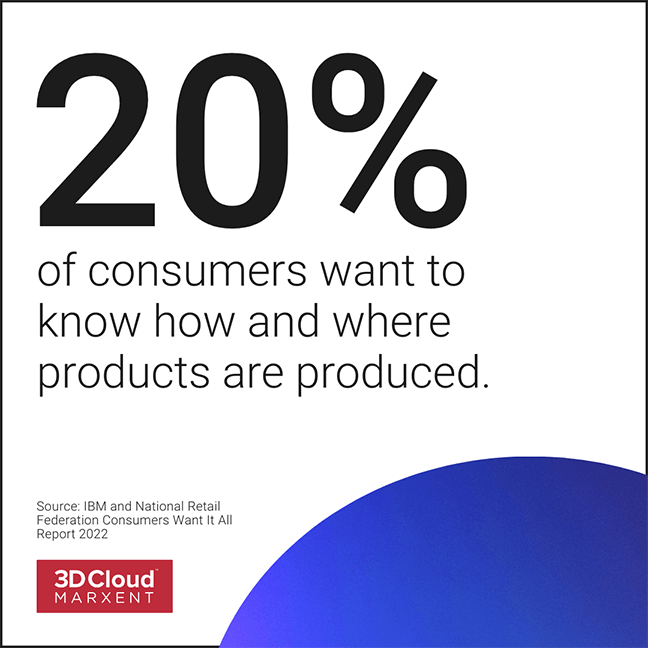
- Re-commerce:
Sustainability and lowering their carbon footprint have become top of mind for one in five consumers. Buyers are interested in how products are manufactured and if the materials are recycled, recyclable, and environmentally friendly. A major trend is purchasing previously owned or returned goods. Smaller companies like Kaiyo make selling or buying gently used or refurbished furniture easy. They offer white glove delivery service, while giant retailers like Amazon offer discounts on returned merchandise to willing buyers.
- Chat (or conversational) commerce:
Consumers want answers, and they want them now. Messaging, AI chatbots, and virtual assistants are all elements of conversational commerce that make shopping more convenient and personal. Furniture brands like IKEA and Roche Bobois live online support system makes furniture buying faster and eliminates the guesswork for the consumer. Amazon’s Alexa voice assistant lets buyers place orders, track packages, reorder, and return products.
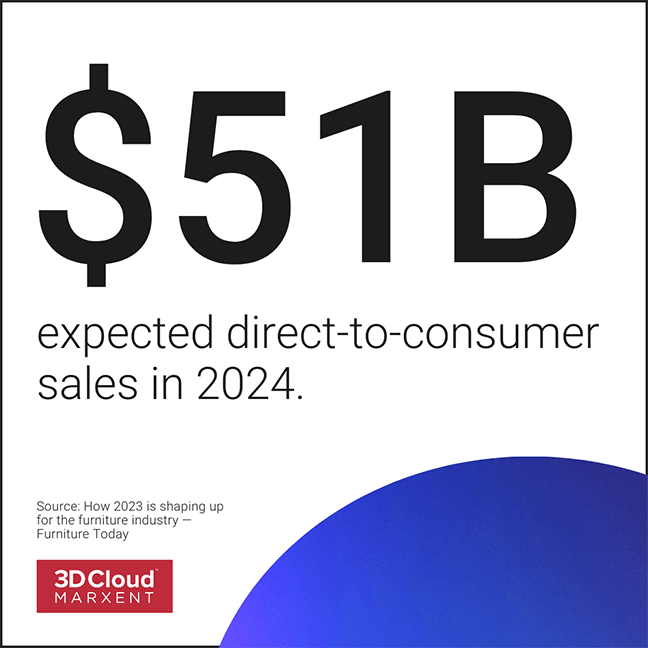
- Direct to Consumer:
Joybird, Article, and Maiden Home are some of the most popular direct-to-consumer (DTC) furniture brands that ‘eliminate the middleman’–and brick-and-mortar stores. The goal is to save money and make quality furnishings more available to everyone—from first-time apartment dwellers to home redecorators. DTC brands have a more hands-on, personal approach and control manufacturing, marketing, and sales. Mattress companies make it easy to upgrade and account for about 12% of the US mattress market, according to Forbes “2023 Review: Direct to Consumer Mattresses from Casper, Helix Sleep and Purple.”
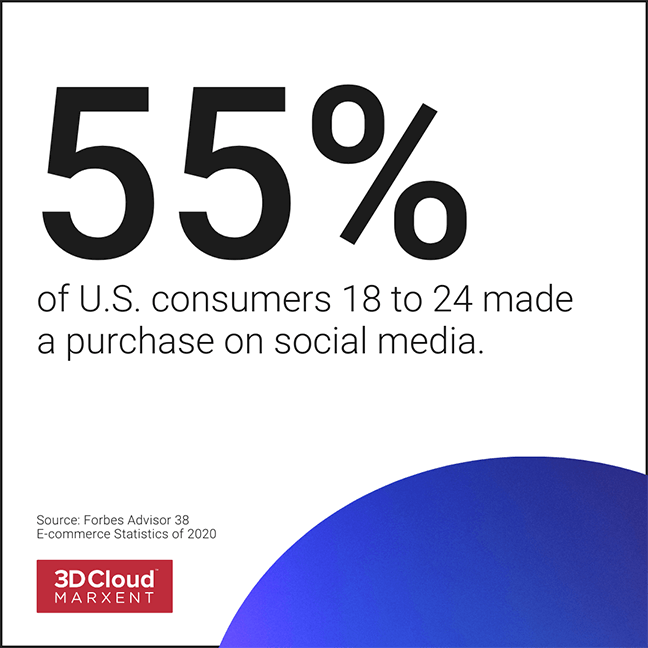
- Social commerce:
Social media platforms with built-in e-commerce functionality are popular, particularly with younger consumers who trust and spend time on platforms like Instagram, Snapchat, TikTok, and WeChat. People like the convenience of making a buying decision based on a strong attraction to products. Integrated social commerce is likely to grow since, according to DataReportal, the typical working-age user spent 2.5 hours daily on social media in January 2023.

- AI everywhere:
AI is already a force in robotics, medicine, transportation, science, and simpler functions like phone apps. The technology will find its place in furniture e-commerce. Jessie Healy says, “AI will impact everything—from how we optimize advertising to copywriting and content—as well as how we read and analyze data. Those that are quickest to adopt it will get a great head start!”
Gartner predicts that by the end of 2023, AI will handle 15% of all customer service interactions globally without interference from its human counterpart. In e-commerce, they predict there are five trends to look for in 2024 and the next decade:
- Conversational AI chatbots that are capable of lifelike conversation.
- Lead engagement and retargeting to reach out to cold and warm leads and retarget customers in the sales funnel who haven’t made a purchase yet.
- Contextual search for more accurate search results that can also make related search suggestions even more powerful.
- AI recommendation engine, voice, and visual search for screen-free, hands-free smart assistants.
- Big data analytics will more effectively monitor sales, demand, marketing strategies, inventory, supply chain, and more in real time.
- Product customization:
Personalization and customization are so essential to consumers that product customization is verging on table stakes. People want to express their style and personality, particularly through furniture that will have a long, highly visible life in their home. In a period of fundamental change and post-pandemic, people’s homes and offices have taken on greater importance. Latest Technology and Trends Insights 2023 Overview: “Customized Furniture Market” Future Business Insights, with Dynamic Growth Drivers and Regional Outlook” states that the expected compound annual growth rate for furniture customization is 12.21% from 2022 through 2028.
Modular pieces are also gaining traction. Civil sells customizable storage systems and Expand Furniture and Lovesac offer modular seating. Furniture retailers like Wayfair and direct-to-consumer brands like Inside Weather and Joybird all offer custom pieces. Showing how the furniture will fit in a space, the material, color, and pattern, plus how accessories and add-ons will look, allows purchasers to get what they want.
2024 e-commerce trends & table stakes
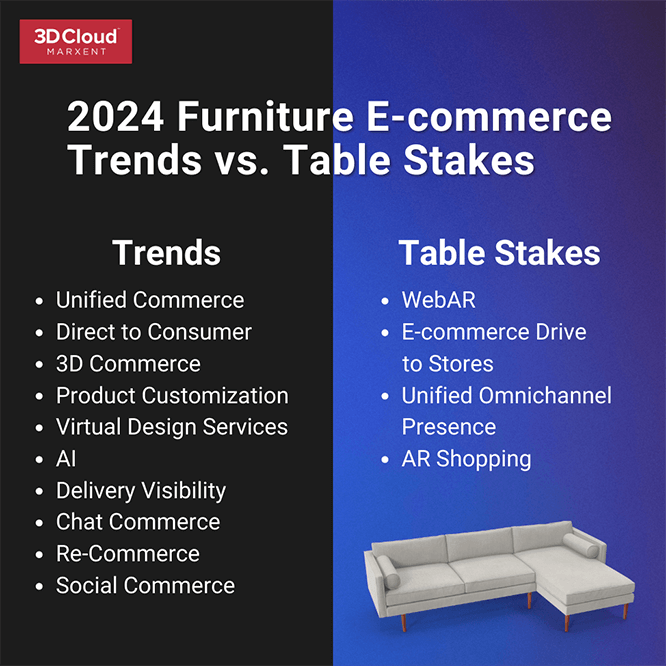
Furniture e-commerce trends that are now table stakes
Yesterday’s trends become today’s table stakes in furniture e-commerce. Running an effective business means providing a compelling experience with WebAR, omnichannel marketing, AR shopping experiences, and driving consumers to stores with e-commerce.
- WebAR:
Web-based augmented reality supports AR functionality within a web browser. WebAR increases the reach of AR use cases because there are fewer hardware and software requirements, and you can reach users across all platforms, browsers, and devices. Retailers can launch a digital 3D overlay of products from an AR content cloud-based catalog that customers can interact with to see different configurations and products and view them in their physical environment.
For example, Jerome’s was the first U.S.-based furniture retailer to launch WebAR in that vertical. The company worked with 3D Cloud by Marxent to WebAR-enable over 1,000 product SKUs. Jerome’s has found that offering this feature also helps mitigate customer returns.
- Using e-commerce to drive customers to physical stores
“I would encourage furniture retailers to invest in email marketing—collecting email addresses of current and potential customers through campaigns and at point of purchase,” suggests Healy. “Then they can use this method to nurture customers and get them to visit stores—ideally by offering extra services to in-person clients that they can’t get online.”
When customers don’t make a purchase, retarget them with ads tailored to your potential buyers’ interests. For example, if someone was looking at dining tables on your site but didn’t buy anything, you could show them tailored ads for dining chairs on sale at a physical store or offer an in-store design session.
- AR furniture shopping experiences
AR experiences are accessible, immersive, and realistic, so naturally, consumers are enthusiastic about this becoming part of their buying journey. Research from Google shows that 90% of Americans currently use or would consider using AR for shopping. Over three billion devices worldwide running Android or iOS are compatible with WebAR technology. Of those, between 100 million and 250 million Android smartphones support AR, according to Market U.S.’s report in 2022.
- Unified omnichannel presence:
Omnichannel marketing is an integrated approach that uses multiple channels, like websites, email, social media, and brick-and-mortar stores, to create a seamless user experience across every touch point. Omnichannel commerce allows stores and brands to bridge the gap between online and offline sales to complement each other and empower customers to choose and purchase products whenever and wherever they prefer. Shoppers can decide where and how to buy and perceive the retailer not as a set of outlets but as a brand.
“Furniture stores need to communicate with people on every channel and have content that is optimized for each,” advises Healy. “They should be creating authentic short-form videos on TikTok and Instagram, engaging informative content for email, and advertising that uses social-proof and social-first content. Forming strong partnerships with creators that can bring their brand to life for their followers is another useful tactic.”
Furniture e-commerce brands implementing trends and table stakes
Thriving furniture e-commerce brands lean into trends and table stakes. La-Z-Boy embraces WebAR. American Furniture Warehouse uses 3D configurators to make a sale. Placemakers uses a 3D Design Planner to help shoppers visualize it in their space better.
- La-Z-Boy: Implementing WebAR for furniture
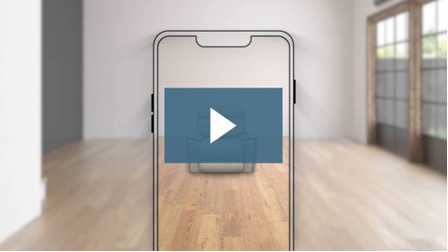
A pioneer in the furniture industry, La-Z-Boy leverages an app-less WebAR OnDemand technology and 3D product configuration. The company offers over twenty-nine million possible configurations. Its WebAR OnDemand must serve up higher levels of convenience to shoppers who want to research, configure, and plan furniture purchases online before a physical store visit.
- Implementing 3D furniture

American Furniture Warehouse offers customers a sectional sofa configurator. Shoppers can use the configurator to see furniture measurements and visualize the exact arrangement they want to buy. Once the design is complete, they can add the items to an e-commerce shopping cart with just one click.
- Implementing a combination of consumer and trade professional 3D room planner
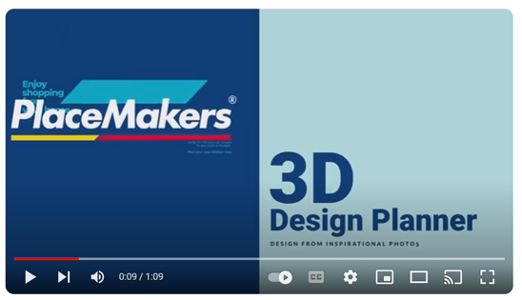
PlaceMakers, New Zealand’s leading supplier of building materials and hardware, offers pros and consumers a 3D kitchen planner enabled by the Marxent 3D Cloud. Customers drag and drop 2D design inspiration photos into a 3D floor plan. This initiative is a part of the company’s commitment to provide online tools that are easy and engaging for its customers from a single online app. PlaceMakers also provides the 3D Design Planner in its retail stores during in-person design appointments.
Future of furniture e-commerce
Hyper-personalized marketing is the future of furniture e-commerce. We’ll see it take many forms. Richer 3D visualizations and product customizations will offer more satisfaction for customers. The metaverse will reveal even more marketing options.
“The battleground for success in e-commerce will come down to how good a brand is at building long-term, authentic relationships with customers. I see the big levers of growth being the ability to create community, to generate social proof content about the brand, and leveraging emerging social commerce opportunities like TikTok Shop,” shares Jessie Healy, ecommerce marketing expert.
Technology will help us gather information about the customer on an emotional level at an unprecedented speed. By understanding a customer’s responses to specific designs and gathering their feedback and sentiment, AI will push customization to an entirely new level. Retailers can use that data to inform product lines and offerings. We are already seeing how adding a gen AI chatbot to a product configurator experience can minimize the time-to-market for customer transformations.
Al will play a role in furniture shopping, helping people pick the right products for their space. “addition to Design from Photo for the 3D Cloud Kitchen Planner now allows for an automated design option where customers can scroll through a social media-like feed for room inspiration and then apply the style they like directly to their floor plan,” says Besecker. “The same tech is coming soon to the furniture vertical. I don’t think we can underestimate or even know all the ways AI will reshape the industry–except to know that it will take us into more hyper-personalized, immersive experiences like smart showrooms that interact with customers, including interior design assistance.”
Why now is the time to embrace e-commerce furniture trends
The adage “he who hesitates is lost” was never truer than in the context of e-commerce. Technology is accelerating, and all of it is being embraced by a public excited by its possibilities—especially by young consumers who are the customers of the future.
Salesforce published research reporting that 80% of customers say the experiences provided by a company are as important to them as its products and services. That’s why it’s essential to get on board with 3D modeling as soon as possible–and maybe even step into the metaverse, which combines what’s great about online shopping with moving around a physical store.
3D Cloud by Marxent: Making 3D Commerce easy for furniture retailers
Ready to embrace the top 2024 table stakes and make the most of furniture e-commerce? Marxent’s 3D Cloud Product Visualization Solution for Furniture can help you easily deploy WebAR, 3D product configurators, 3D room planners, and more.
If you’re interested in selling more furniture sets online, the 3D Cloud Room Visualizer App is an ideal way for furniture stores and DIY retailers to show off their home goods to shoppers. Scalable, secure, and proven, 3D Cloud by Marxent is the enterprise platform of choice for leading furniture retailers and manufacturers. Use 3D Cloud by Marxent’s complete suite of 3D apps and enterprise-ready CMS to launch your furniture e-commerce experience in just 8-10 weeks.












